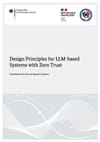⚡ Quick Summary
This joint report by Germany’s BSI and France’s ANSSI offers a principled framework for securing LLM-based systems through the lens of Zero Trust Architecture. It identifies risks unique to agentic and multi-modal LLM applications—such as prompt injection, data leakage, and escalation of privileges—and lays out a set of six design principles to harden these systems at the application layer. The report emphasizes proactive defense, human oversight, and verification-by-default as essential to building secure and trustworthy AI agents. It’s a foundational document for government, enterprise, and critical infrastructure actors deploying LLMs in sensitive or autonomous environments.
🧩 What’s Covered
The document is structured around six design principles, each introduced with a definition, risk scenarios, and recommended mitigations:
- Authentication and Authorization
- Ensures access control for users, agents, and components.
- Highlights risks like privilege escalation, unrevoked admin rights, and RAG-based data leaks.
- Recommends MFA, attribute-based access control, and multi-tenant segregation .
- Input and Output Restrictions
- Focuses on preventing prompt injection and data exfiltration.
- Introduces mitigations like input tagging, gateways, trust algorithms, and human-in-the-loop output control.
- Warns against markdown injection and external tool misuse .
- Sandboxing
- Advocates for memory isolation, network segmentation, and internet access restrictions.
- Describes risks from shared session memory, recursive LLM loops, and untrusted plugins.
- Emphasizes context window hygiene and environment segregation .
- Monitoring, Reporting, and Controlling
- Stresses the need for real-time observation and threat detection.
- Provides mitigations like token limits, logging, anomaly detection, and automated threat responses.
- Threat Intelligence
- Encourages integration of real-time threat feeds and red teaming.
- Targets supply chain attacks and novel prompt injection techniques .
- Awareness
- Recognizes the human factor as critical in Zero Trust environments.
- Recommends red teaming, security training, and stakeholder education on LLM-specific risks.
The report concludes by rejecting fully autonomous LLM agents for sensitive use cases and argues for human-centric design, explainability, and constrained system autonomy .
💡 Why it matters?
This report offers one of the first government-backed, system-level frameworks for securing LLM-based applications. While much AI security guidance focuses on model robustness or dataset curation, BSI and ANSSI pivot toward end-to-end operational resilience—emphasizing orchestration, memory boundaries, and access controls. The Zero Trust lens is especially timely as LLMs shift from single-user assistants to autonomous agents operating across networks, APIs, and multi-agent systems. This paper bridges AI safety with practical cybersecurity—providing a shared vocabulary for regulators, developers, and infrastructure operators.
❓ What’s Missing
- Development Phase Gaps: While the paper mentions training and data security, its primary focus is the application layer—leaving out threats during model development, pretraining, and fine-tuning.
- No Tooling or Frameworks: The report avoids naming specific technologies (e.g., LangChain, Guardrails, Constellation) that implement these principles in practice.
- Cloud & Supply Chain Security: Risks tied to hosting environments (e.g., shared GPU resources or container leakage) are explicitly excluded.
- Limited AI-Specific Metrics: There’s no reference to AI-specific evaluation metrics (e.g., jailbreak resistance, hallucination scoring) despite their relevance for Zero Trust policy enforcement.
👥 Best For
- System Architects & Security Engineers building LLM-integrated applications.
- Government & Critical Infrastructure Teams deploying AI in regulated environments.
- AI Governance Professionals designing risk frameworks and policies.
- CISOs & Red Teamers seeking practical hardening measures for prompt injection and agent misuse.
📄 Source Details
- Title: Design Principles for LLM-based Systems with Zero Trust
- Authors: German Federal Office for Information Security (BSI) and French ANSSI
- Last Updated: August 2025
- Scope: Application-layer design for LLM-based systems
- Notable References: OWASP Top 10 for LLMs (2025), NIST Zero Trust (2020), EU AI Act (2024)
📝 Thanks to
The German BSI and French ANSSI for delivering a forward-thinking, vendor-neutral security guide that merges classical Zero Trust principles with emerging LLM-specific risks.


